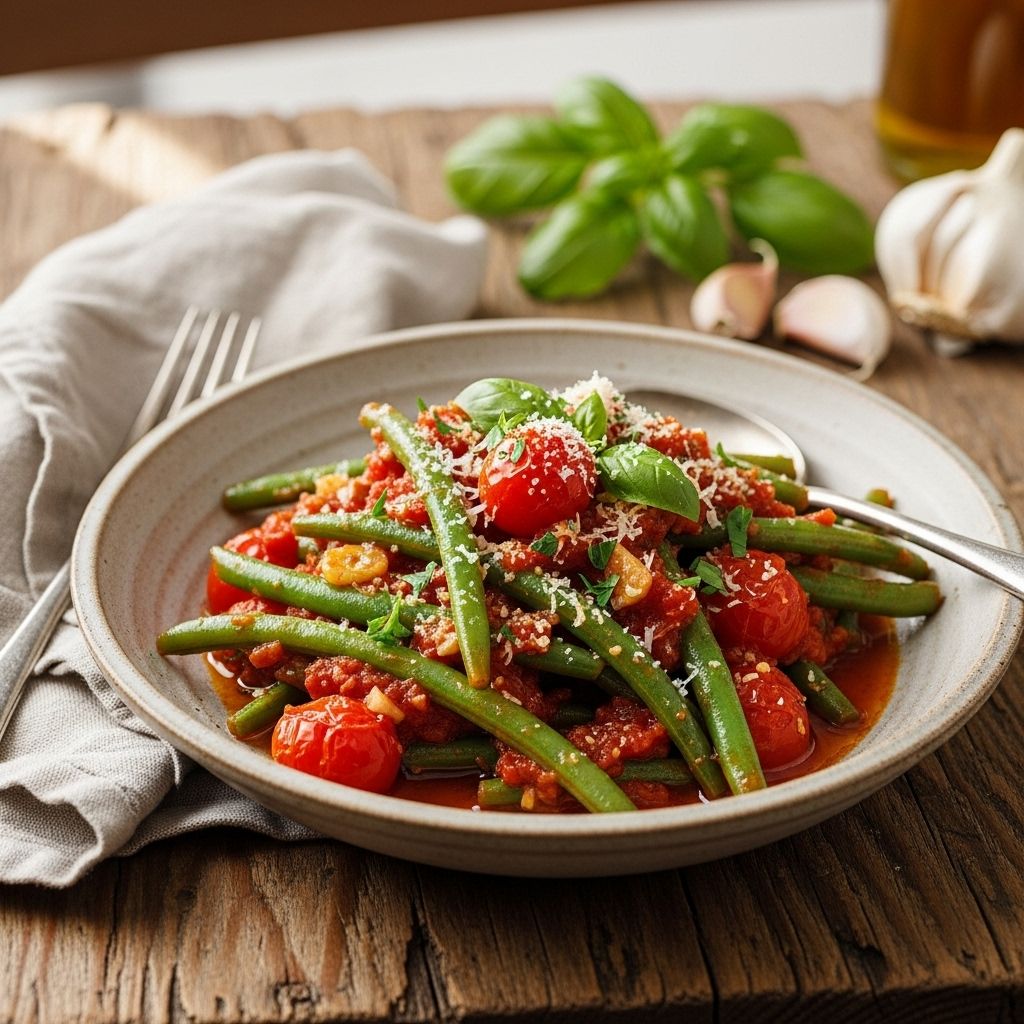Italian-Style Braised Green Beans with Tomato and Garlic
A simple method yields meltingly soft pods cloaked in rich, garlicky tomato sauce.

Braised green beans with tomatoes and garlic—known as fagiolini in umido or fagiolini all’italiana—are a staple of Italian home cooking and summer vegetable feasts. This simple but deeply satisfying side dish transforms humble beans into something rich, saucy, and nuanced. Whether you use Romano beans, Italian pole beans, or classic green beans, braising paints them in new colors: tender, infused with complex flavor, and saturated with olive oil and the sweetness of ripe tomatoes. This guide covers everything from ingredient choices and preparation tips to techniques for perfect braising, finishing touches, and serving ideas.
Why Braise Green Beans?
Most green bean preparations in the U.S. aim for snappy texture—but in Italian tradition, beans are often gently simmered or braised until meltingly soft. This method:
- Concentrates flavors as the beans simmer in a flavorful tomato and garlic sauce.
- Cultivates a tender, lush texture that absorbs aromatic olive oil and garlic.
- Turns even the toughest summer beans into a delicacy that sings next to main courses or shines on its own.
Braising also gently breaks down the beans’ fibers and unites them with the tomato sauce, which reduces into a thick and tangy glaze.
Essential Ingredients
This dish thrives on quality, seasonal ingredients—here’s what you’ll need and why each matters.
| Ingredient | Best Choices & Tips |
|---|---|
| Green Beans | Romano or Italian beans have a flat shape and meaty texture, but regular green beans or French haricots verts work well. |
| Tomatoes | Fresh summer tomatoes are ideal. In off-season, use good quality canned tomatoes (such as San Marzano). |
| Garlic | Adds aromatic backbone. Use fresh whole cloves (smashed slightly to release flavor). |
| Onion (optional) | For extra sweetness and depth; common in many regional recipes. |
| Olive Oil | Extra-virgin is best for fruity flavor and for finishing. |
| Salt & Pepper | Essential for seasoning; use kosher or sea salt for best results. |
| Crushed Red Pepper Flakes (optional) | For a subtle heat—especially in southern Italian or Mediterranean variations. |
| Sugar or Lemon | Sometimes a pinch of sugar or a final squeeze of lemon balances acidity. |
| Parsley or Other Herbs | Fresh flat-leaf parsley, basil, or even sage for finishing and garnish. |
Choosing and Preparing the Beans
Romano beans—also called Italian or flat beans—are especially suited to braising. Their thick, muscular pods soak up sauce and soften beautifully. If using string beans or haricots, opt for the freshest you can find. To prep:
- Snap off stem ends (and the tips if tough).
- Break or cut beans into 2- to 3-inch pieces for even cooking and easy eating.
Rinse well and let drain before cooking.
How to Prepare Tomatoes for Braising
The sauce’s soul is ripe tomato. If using fresh tomatoes:
- Bring a pot of water to a boil and prepare an ice bath.
- Score an “X” on the bottom of each tomato, blanch briefly (20–30 seconds), then shock in the ice bath. Peel, core, seed (if desired), and chop.
If using canned tomatoes, drain them if packed with excessive liquid and chop as needed. The key is to avoid a watery sauce; it should reduce to coat the beans.
Step-By-Step: Classic Italian Braised Green Beans
1. Sauté Aromatics
Heat a wide, deep skillet or sauté pan over medium heat and add a generous pour of olive oil. Drop in smashed garlic cloves and, if using, thinly sliced onion. Cook gently until fragrant and golden (but not brown).
2. Build the Sauce
Add chopped tomatoes to the pan and stir with the aromatics until they soften and begin releasing their juices. The goal is to create a saucy base before beans go in.
3. Add Beans & Seasonings
Tumble in the prepared beans along with salt, optional red pepper flakes, and a splash of water or additional tomato juice if the sauce looks too thick. Toss everything together.
4. Cover and Braise
- Bring to a gentle simmer, reduce heat to low, and cover the pan (lid slightly ajar).
- Cook, stirring once or twice, until beans are very tender and the sauce is thickened—about 25 to 45 minutes, depending on the beans’ type and age.
Don’t rush this step—slow cooking is what transforms and melds the flavors.
5. Finish and Serve
- Taste and adjust salt and pepper.
- Add a pinch of sugar or a squeeze of lemon if desired, which brightens and balances the tomato’s acidity.
- Scatter the dish with fresh parsley or basil and finish with an extra drizzle of olive oil.
Tips & Tricks for Best Results
- Bean Texture: Italian braided beans are meant to become soft—don’t aim for crispness.
- Oil Generously: This dish celebrates robust olive oil. Don’t skimp, and consider a final drizzle before serving.
- Customizing Heat: Use more or less red pepper flakes to match your taste or omit entirely for a milder dish.
- Make Ahead: The flavors deepen after a rest. This dish holds beautifully for several hours at room temperature or even overnight in the fridge. Gently rewarm before serving.
- Component in Other Meals: Works as a topping for crostini, a bed for roasted meats, or tossed with pasta for simple vegetarian dinners.
Variations Across Italy and the Mediterranean
- Tuscany: Similar braises appear with cannellini beans in a tomato-garlic-sage sauce (see fagioli all’uccelletto).
- Southern Italy: Calabrian and Sicilian versions often include capers, olives, or chili for stronger, savory flavors.
- Greek, Turkish, and Middle Eastern: Similar techniques use lots of olive oil or add potatoes or carrots. Sometimes a bit of sugar is traditional for a darker, richer effect.
- French (Provençal): Summer vegetable braises (ragouts) often feature green beans, tomatoes, garlic, and fresh herbs such as thyme.
Serving Suggestions
- Side Dish: Pairs beautifully with roasted meats, grilled sausages, or seafood.
- Main Course: Spoon over a mound of creamy polenta, rice, or soft-cooked pasta for a meatless main.
- On Toast: Pile warmed beans onto olive-oil-rubbed toasted bread for a rustic starter.
- Room Temperature: Serve as part of an antipasto platter or picnic spread.
Nutritional Highlights
- Rich in Fiber: Long beans and tomatoes deliver excellent dietary fiber for digestive health.
- Healthy Fats: Extra-virgin olive oil is a core healthy fat in Mediterranean diets.
- Vitamins & Minerals: Beans and tomatoes provide vitamins C and K, potassium, and folate.
Frequently Asked Questions (FAQs)
Q: What type of green beans are best for braising?
A: Romano (Italian flat) beans are ideal for braising due to their hearty texture, but regular string beans or haricots verts can be substituted with good results.
Q: Should the beans be tender or crisp?
A: For this dish, beans should simmer until they are very tender—even velvety. Crispness is not traditional in Italian braised beans.
Q: Can I use canned tomatoes?
A: Yes. Use whole peeled or diced canned tomatoes, preferably San Marzano for the best flavor. Drain excess liquid if needed for proper sauce consistency.
Q: How far ahead can I make this dish?
A: Braised green beans can be made a day ahead; flavors improve as they rest. Let come to room temperature or gently rewarm before serving.
Q: Can I freeze leftovers?
A: Yes—portion and freeze in airtight containers for up to 3 months. Thaw and rewarm gently for best texture.
Recipe Card: Italian Braised Green Beans with Tomato & Garlic
- Prep Time: 10–15 minutes
- Cook Time: 30–45 minutes
- Serves: 4–6
Ingredients
- 1 pound green beans or Romano beans, trimmed and cut to 2-3 inch pieces
- 2–3 medium ripe tomatoes, peeled and diced (or 1 cup diced canned tomatoes)
- 3–4 cloves garlic, smashed
- 1 small onion, thinly sliced (optional)
- 1/4 cup extra-virgin olive oil
- Salt and freshly-ground black pepper, to taste
- 1/2 teaspoon crushed red pepper flakes (optional)
- Pinch sugar or squeeze lemon, to taste
- Fresh parsley or basil, chopped
Instructions
- Heat olive oil in a wide skillet over medium heat; add garlic (and onion, if using), cook until golden and fragrant.
- Add tomatoes, season lightly, and cook until they start releasing juice (about 3–5 minutes).
- Add beans, salt, pepper, pepper flakes, and stir to coat.
- Cover, simmer on low heat until beans are very tender and sauce is thickened, 25–45 minutes, stirring once or twice and adding a splash of water as needed.
- Taste; add sugar or lemon if desired. Finish with parsley and extra olive oil. Serve warm or room temperature.
Related Italian Bean & Tomato Dishes
- Fagioli all’uccelletto: Tuscan-style braised white beans simmered with tomato, garlic, and sage for earthy depth.
- Mediterranean Fasolakia: Greek green beans with potatoes, tomato, and olive oil.
- Southern Italian Caponata: Sweet-sour braised vegetables including beans, eggplant, and tomatoes.
Final Tips & Inspiration
- Braised green beans are a testament to the Italian philosophy: simple, top-quality ingredients and patience yield the most rewarding flavors.
- Adapt the recipe with add-ins such as olives, capers, roasted red peppers, or pancetta for new flavor twists.
- Serve leftovers tossed with warm pasta or on crusty bread for a delicious next-day meal.
References
- https://www.tuesdayrecipe.com/recipe-archives/side-dishes/italian-green-beans/
- https://www.fromachefskitchen.com/mediterranean-braised-green-beans-tomatoes/
- https://whipsmartkitchen.com/blog/fagioli-alluccelletto-tuscan-braised-beans/
- https://small-pantry.com/recipes/tomato-braised-potatoes-and-green-beans/
- https://frannielovesfood.com/dinner-recipes/italian-stewed-string-beans/
- https://www.mediterraneanliving.com/italian-green-beans-with-tomatoes-and-garlic/
Read full bio of medha deb












